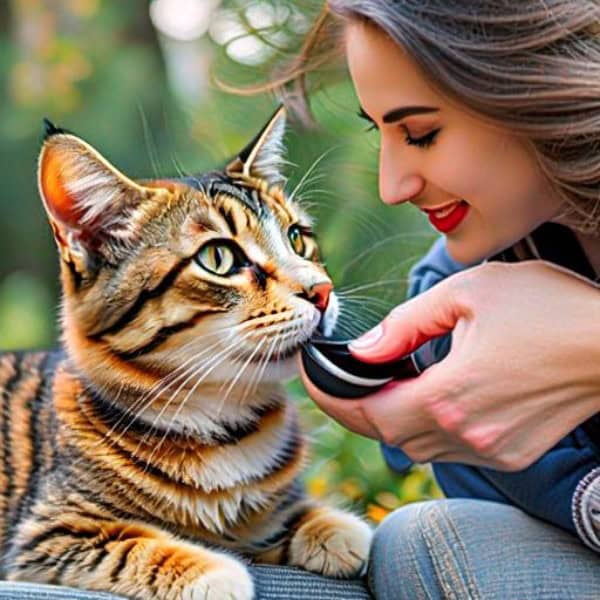It’s 3 AM, and you’re fast asleep when something soft and furry suddenly touches your face. You open your eyes to see your cat’s paw resting gently over your mouth.
Though initially surprised, you’re now used to this strange feline behavior. But why does your cat do this?
Many cat owners are familiar with this peculiar action. Your beloved kitty will lovingly place a paw on your mouth, often while purring or kneading you with his claws. It’s perplexing but also oddly adorable.
While this behavior may seem inexplicable, there are several possible reasons cats touch their owners’ mouths. Exploring potential explanations can help decode this familiar cat mystery.
Some key motivations are communication, affection, attention-seeking, playfulness, territorial marking, or even health issues.
Read on to get to the bottom of this quirky cat conduct. With insight into why cats paw at mouths, you can better understand your pet’s intentions and respond appropriately.
Whether greeting you good morning or soliciting playtime, your cat’s paw on your mouth likely signifies bonding and trust.
Cats Behavior
Cats putting their paw on their human’s mouth is a standard feline behavior. While it may seem odd to humans, experts have several theories about why cats make this kneading and touching gesture.
One of the most prevalent explanations relates to a cat’s nursing instincts as a kitten. Soft paw padding and gentle pressing with extended claws mimic how kittens knead their mother’s bellies to stimulate milk flow while nursing.
Vets and animal behaviorists refer to this instinctual habit as “making biscuits” or “kneading.” So when your cat presses its paw against your mouth, it could be trying to recreate the comforting tactile experience of kneading its mother during early development.
Another reason for this feline behavior is simply communication and affection. Cats have scent glands in their paw pads, so by placing their paw in your mouth, they spread their scent and communally share smells.
It can signify bonding, especially if the cat also purrs while performing this “petting pet peeve” gesture. Consider it a request to pay attention and reciprocate some petting or affection.
Communication and Affection
Cats use paw touching as a social communication gesture and a sign of bonding. When a cat puts its paw on your mouth, it attempts to communicate with you and show affection.
The paw is one of the areas where cats have scent glands. They spread their scent by putting their paw on your mouth and marking you as an essential social group member. This allows you to carry their scent around, which can comfort your cat.
Cats also regard paw touching as a sign of trust. The mouth is a vulnerable area, so placing a paw there shows that the cat feels safe and comfortable with you. It indicates that the cat views you as a friend rather than a threat.
Paw touching is often seen when two cats are bonding. Your cat is trying to strengthen their bond with you by mimicking this social behavior. It is a gesture that says, “I feel connected to you and want to show affection in our relationship.”
So next time your cat puts its paw on your mouth, it says, “I like you!” It’s a compliment and a sign that your cat feels attached to you. Though it may seem odd, it is their unique way of communicating warmth and friendship.
Attention-Seeking
Cats often put their paw on their owner’s mouth to solicit attention. This frequently occurs when your cat wants food, water, playtime, or simply your affection.
Cats learn that this action prompts your response, so it gets reinforced when you give them what they want.
To curb this behavior, ignore your cat when it paws at your mouth and reward it with attention only when it exhibits preferred behaviors. You can also redirect its pawing by engaging it with an interactive toy when it starts.
Not scolding or punishing it is essential, as negative reinforcement can worsen the behavior. With time and consistency, your cat will learn better ways to seek attention.
Play Time
Your cat may put its paw on your mouth to engage you in play. Cats commonly use their paws during play by batting, swatting, and gently scratching. Placing a paw in your mouth can invite your cat to play with you.
Cats, especially younger cats, have solid instincts for play-fight and hunting. By putting their paw in your mouth, they may stimulate you to nibble or pretend to bite their paw playfully. This mimics natural cat behavior since kittens learn hunting skills by playing with their mothers and littermates.
If your cat frequently puts its paw on your mouth, it likely wants more active playtime. Schedule regular play sessions with interactive toys to provide an outlet for its energy and predatory instincts.
Dragging toys across the floor, throwing balls, and playing with feather wands are great ways to keep your cat interested.
Dedicate 10-15 minutes 2-3 times daily to play with your cat. This will help satisfy their play needs and reduce unwanted behaviors like batting your face.
Be sure the play includes running, jumping, pouncing, and stalking to mimic their natural hunting behavior.
Reward your cat with treats after a vigorous play session. With more consistent playtime, your cat will be less likely to see your mouth as a toy.
Marking Their Territory
Cats may touch their paws to your mouth to mark you as theirs, similar to rubbing up against your legs. This lets other animals know you belong to them. Cats have scent glands in their paws, so touching your mouth deposits their scent.
It’s their way of claiming ownership of you. Some cats are more possessive than others in wanting to mark their territory. If they do it frequently, it means you belong to them!
While this behavior comes from an instinct, you may want to discourage it if the cat tries to do it too often. Here are some tips:
- Gently remove their paw and say “no” firmly when they try to touch your mouth. Be consistent.
- Try clipping your cat’s nails regularly to remove the sharp tips. This makes the pawing less unpleasant.
- Give your cat plenty of positive attention and playtime so they feel less need to claim you. Satisfy their instincts in other ways.
- Provide other surfaces where they can deposit their scent glands, like scratching posts.
With patience and consistency, you can teach your cat that putting their paw in your mouth is an unwanted behavior.
Remember that it’s not done out of aggression, just their innate desire to mark their territory. Satisfying that need in more appropriate ways can curb the behavior over time.
Aggression
Some cats will put their paw on your mouth as an act of aggression or to exert dominance over you. This is more common in cats that haven’t been properly socialized.
In this context, the paw on mouth move is a controlling gesture that sends the message “stop talking” or “pay attention only to me.”
Cats that repeatedly paw at your mouth aggressively need this behavior curbed through training. You can discourage an aggressive paw to the mouth by:
- Gently taking their paw and moving it away from your face every time they do it.
- Please do not give them any attention when they paw your mouth, which rewards the behavior. Completely ignore them instead.
- Providing plenty of appropriate outlets for them to scratch and play hunt, such as scratching posts, interactive toys, and playtime. A bored cat is more likely to act aggressively, like unwanted pawing.
- Use aversives like a water spray bottle or loud noise deterrent when they paw aggressively. The goal is to startle them just enough to disrupt the behavior.
- Trying synthetic feline pheromones like Feliway to reduce stress and aggressive behaviors.
With proper training and adjustments to their environment, you can curb aggressive and domineering paw gestures in cats.
The key is to be consistent and not reward unwanted behavior. Instead, redirect them to appropriate scratching posts and toys.
Health Reasons
Some medical conditions can cause cats to exhibit unusual behaviors, like placing paws over their owner’s mouth. Here are some potential health-related causes to be aware of:
Dental Pain
Cats are prone to dental diseases, such as tooth resorption, abscesses, and gingivitis. Dental pain can cause cats to act out in strange ways.
A cat putting its paw on your mouth may be its way of showing you that its mouth hurts. Note if your cat exhibits other signs, like reduced appetite and drooling.
A veterinary dental exam can determine if there are any dental issues causing discomfort.
Neurological Disorders
Neurological conditions like dementia, brain tumors, and nerve damage can sometimes manifest in odd behaviors. For example, a cat’s paw on your mouth could stem from disorientation, lack of inhibition, or sensory changes.
If the behavior arises suddenly in an adult or senior cat, having a veterinarian do a neurological exam to rule out any issues is a good idea.
When to Call the Vet
Contact your veterinarian if your cat repeatedly and excessively puts its paw in your mouth. This behavior, combined with other symptoms like appetite changes, lethargy, hiding, or aggression, warrants a veterinary visit.
The vet can perform tests to pinpoint any underlying medical causes for the behavior. Early treatment of health issues leads to better outcomes.
Stopping Unwanted Behavior
If your cat’s paw on your mouth is unwanted behavior, there are some things you can try to discourage it. Here are some tips:
- Redirect your cat’s paw away from your face whenever they try to put it in your mouth. Say “no” firmly or make a loud noise to signal this is undesirable. Reward them with pets or treats when they stop.
- Provide alternate outlets for affection, such as a cat tower or scratching post. Encourage pawing and rubbing on these instead.
- Clip your cat’s nails regularly to minimize discomfort from accidental scratches.
- Ignore the behavior by turning your head away and not giving your cat attention when they paw at your mouth. Only give attention when all four paws are on the floor.
- Consider clicker training to reinforce keeping paws off your face. Click and reward when they lift their paw before touching your mouth.
- Play with interactive toys whenever your cat wants playtime, not just affection. Distract them from your face.
- If your cat persists, consider squirting water or shaking a can filled with coins to startle them into stopping. Use only as a last resort.
- Ensure your cat has enough enrichment and exercise opportunities to redirect energy positively.
With patience and consistency, you can train your cat to show affection without putting their paws on your mouth. Redirect the behavior into acceptable alternatives.
Conclusion
In summary, there are several possible reasons why your cat may put his paw in your mouth:
- Communication and affection. Cats use paw gestures to show love and bond with their owners. Placing a paw in your mouth is your cat’s way of connecting with you.
- Attention-seeking. Your cat may be looking for playtime or food and uses this gesture to get your focus when you are distracted.
- Territorial marking. Cats have scent glands in their paws and may use this motion to mark you as their territory.
- Aggression or overstimulation. Sometimes, pawing can signal that your cat feels irritated or overwhelmed and needs space.
While this behavior is usually benign, monitor your cat to ensure there are no underlying medical issues. Pay attention to what precedes the paw motions to better understand the cause.
You can gain insight into your cat’s unique personality and what he’s trying to say with patience and care. The bond between cats and their owners relies heavily on mutual understanding.

